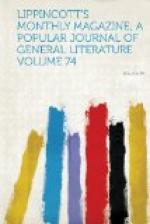M.H.
LITERATURE OF THE DAY.
Birds and Poets: with other Papers. By John Burroughs. New York: Hurd & Houghton.
A duodecimo that discourses on equal terms of Emerson and the chickadee, and unites Carlyle and the author’s cow with a cement or filling-in indescribable in variety and in the comminution of materials, need not be held to strict account in the matter of neatness or accuracy of title. The closing article, headed “The Flight of the Eagle,” is the most remarkable of the collection. Who would suspect, under such a heading, an elaborate eulogy of Walt Whitman? The writer is obviously more at home among the song-birds than among the Raptores, unless he be the discoverer of some new species of eagle characterized by traits very unlike those of other members of the genus. It were to be wished that he had left out the disquisition on Whitman, for it is a jarring chord in his little orchestra of lyric and ornithologic song. He might have kept it by him till the longer growing of his critical beard, and then, if still a devotee at that singular shrine, have expanded it into a volume or two explanatory of the imagination, animus and metre of his favorite bard.
The feathered warblers have always been popular with the featherless, who are indebted to them for no end of similes and suggestions. What would poetry be without the skylark, the nightingale, the dove and the eagle? It is far yet from having exhausted them. It cannot be said to have approached them in the right way—on the most eloquent and interesting side. It forgets that each species of bird stands by itself, and has its special life and history as truly as man. We counted thirty-nine kinds in a grove the centre whereof was our delightful abode for two-thirds of the past summer, each endowed with its separate outfit of language, ways and means of living, tastes and political and social notions. In each, moreover, individualism showed itself—if not to our apprehension as articulately, yet as indubitably, as among the race which considers them to have been all created for its amusement and advantage. It does not take long, superficial as is our acquaintance with their vernacular and the workings of their little brains, to single out particular specimens, and perceive that no two “birds of a feather” are exactly alike. A particular robin will rule the roost, and assert successfully for his mate the choice of resting-places above competing redbreasts. It is a particular catbird, identified, it may be, by a missing feather in his tail, that heads the foray on our strawberries and cherries. We recognize afar off either of the pair of “flickers,” or yellow-shafted woodpeckers, which have set up their penates in the heart of the left-hand garden gatepost. The wren whose modest tabernacle occupies the top of the porch pilaster we have little difficulty in “spotting” when we meet her in a joint




